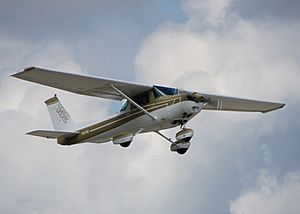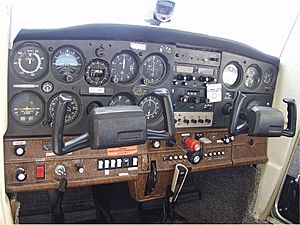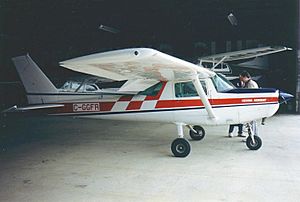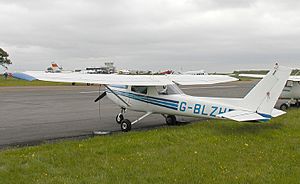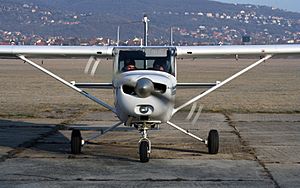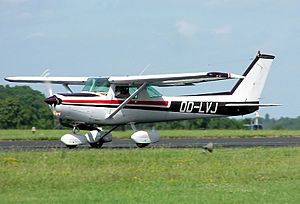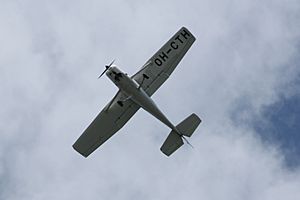Cessna 152 facts for kids
Quick facts for kids Cessna 152 |
|
|---|---|
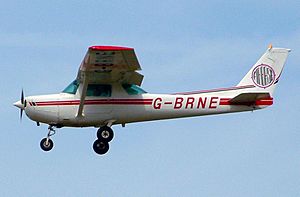 |
|
| Cessna 152 | |
| Role | Basic trainer, GA private aircraft |
| National origin | United States |
| Manufacturer | Cessna |
| Introduction | 1977 |
| Primary users | Mexican Navy Bangladesh Army Bolivian Air Force |
| Produced | 1977–1985 |
| Number built | 7,584 |
| Developed from | Cessna 150 |
The Cessna 152 is a small American airplane. It has two seats and fixed landing gear. People mostly use it for flight training and for personal trips. This plane was built based on an older model, the Cessna 150. It has a slightly stronger engine and a few small improvements.
Even though the Cessna 152 stopped being made almost 40 years ago, many are still flying today. They are often used to teach new pilots how to fly.
Contents
Learning About the Cessna 152
How the Cessna 152 Was Developed
The first Cessna 152 planes were delivered in 1977. They were designed to be a modern version of the popular Cessna 150. The Cessna 152 was also made to compete with new planes like the Beechcraft Skipper and Piper Tomahawk. These planes came out in the same year.
Cessna wanted the new 152 to carry more weight. They also wanted it to be quieter inside and out. Plus, it needed to run better on the new 100LL fuel.
Most Cessna 152s were built at the Cessna factory in Wichita, Kansas. Some were also made in France by a company called Reims Aviation. These French-built planes were called F152 or FA152.
Cessna stopped making the 152 in 1985. This was when they stopped making all their small planes. By then, 7,584 Cessna 152s had been built around the world. This number includes special versions like the A152 and FA152 Aerobat, which could do aerobatic stunts.
In 2007, Cessna announced a new plane to replace the 152. It was called the Cessna 162 Skycatcher. However, production of the Skycatcher ended in 2013.
Key Design Features of the Cessna 152
The Engine: Powering the Plane
All Cessna 152s use a Lycoming O-235 engine. This type of engine has been made since 1942. The Lycoming engine gave the Cessna 152 more power than the older Cessna 150. It also worked better with the newer 100LL low-lead fuel.
Planes made between 1977 and 1982 had a 110 horsepower engine. Later, in 1983, a slightly different 108 horsepower engine was used. This new engine helped reduce problems with lead buildup. This engine was used until 152 production stopped in 1985.
The Airframe: What the Plane is Made Of
The main body of the Cessna 152 is made mostly of metal. It uses a strong aluminum alloy with parts held together by rivets. Some parts, like the wingtips, are made from glass-reinforced plastic. The body is built with strong frames and long beams.
The wings are supported by struts. They are designed to help the plane fly steadily. The tips of the wings are angled slightly. This helps the ailerons work better when the plane slows down a lot.
Early models from 1978 had a single nose cover. To remove it, the propeller had to be taken off. In 1979, a new nose cover was introduced. It could be split into two parts, making it easier to remove without taking off the propeller.
Flying Controls: How Pilots Steer
Most Cessna 152s have dual controls. This means both the pilot and co-pilot (or instructor and student) can control the plane.
The plane has ailerons that move up and down to help the plane roll. It also has flaps that extend to help the plane take off and land. These flaps are moved by electricity. The rudder helps steer the plane left and right. The elevators move up and down to control the plane's nose. There's also a small trim tab on the elevator. This helps the pilot keep the plane flying straight without constantly pushing the controls.
Landing Gear: For Taking Off and Landing
The Cessna 152 has fixed tricycle landing gear. This means it has two main wheels and one nose wheel. The main wheels are covered by fairings and have a step for getting into the cabin.
The nose wheel is connected to the engine mount. It has a special shock absorber to handle bumps. The nose wheel can turn 30 degrees to either side. It is connected to the rudder pedals, so pilots can steer it on the ground.
The plane has disc brakes on the main wheels. Pilots press the top part of the rudder pedals to use them. They can also use the brakes to make very sharp turns on the ground. There's also a parking brake system.
The standard tires are 600 X 6 for the main wheels and 500 X 5 for the nose wheel.
Cool Modifications for the Cessna 152
Many changes can be made to the Cessna 152. Here are some popular ones:
Tailwheel Landing Gear
Some 152s are changed to have a tailwheel instead of a nosewheel. This means the main wheels are moved forward, and a small wheel is added at the back. This change helps the plane take off and land in shorter distances. It can also make the plane fly about 10 knots (18 km/h) faster.
STOL Kits: Short Takeoff and Landing
STOL modification kits can be added to the wings. Most of these kits help the plane take off and land in very short spaces. For example, the Horton STOL kit adds a special cuff to the front edge of the wing. This helps the plane lift more. With these kits, the plane can land in just two fuselage lengths. Takeoff performance also gets much better.
Engine Upgrades
The engine's power can be increased. One popular change is the Sparrow Hawk power package. This boosts the engine to 125 horsepower. However, this upgrade means the engine needs to be checked more often.
Other Useful Changes
- Flap gap seals: These reduce drag and help the plane climb faster.
- Different wingtips: Some new wingtips can make the plane fly faster or slow down better.
- Auto fuel STCs: These allow the plane to use cheaper car fuel instead of expensive aviation fuel.
- Auxiliary fuel tanks: These add more fuel capacity for longer flights.
- Door catches: These replace the original door latches that sometimes break.
- Belly fuel drain valves: These help drain fuel from the lowest point of the fuel system.
Different Types of Cessna 152s
The Cessna 152 has four main versions. All of them use the Lycoming O-235 engine:
- 152
- This is the standard two-seat plane for touring. It has fixed landing gear and a 110 horsepower engine. 6,628 of these were built. There was also a 152 II version with better electronics. These were made from 1978 to 1985.
- A152 Aerobat
- This is a two-seat plane that can do aerobatic stunts. 315 were built. It was built to handle strong forces during stunts. It had special seat belts, skylights, and doors that could be removed quickly. It also had a unique checkerboard paint design. It was made from 1978 to 1985. This plane can do stunts like barrel rolls, loops, and spins.
- F152
- This is the Model 152 built by Reims Aviation in France. 552 were built.
- FA152 Aerobat
- This is the Model A152 Aerobat built by Reims Aviation in France. 89 were built.
- C152 II
- This is not a separate model. It's a standard 152 with an upgraded equipment package called "Nav Pac." It includes better electronics for flying in different weather.
- C152 T
- This is also not a separate model. The "T" stands for "trainer." It's a standard 152 with equipment suitable for flight schools.
- C152 Aviat
- This is not a new model. It refers to Cessna 152s that have been completely rebuilt and updated by a company called Aviat.
Who Uses the Cessna 152?
Civilian Users
The Cessna 152 is very popular with flight schools. Many private pilots also own and fly them.
Military Users
Some countries' militaries have used the Cessna 152:
- Argentine National Gendarmerie used three planes starting in 2004.
- Bangladesh Army used the A152 Aerobat version.
- Bolivian Air Force had 12 planes in 1987.
- Botswana Defence Force Air Wing used two A152s.
- Gabonese Air Force used one F152.
- Lesotho Defence Force used one A152.
- Mexican Navy used seven planes starting in 1979.
Cessna 152 Specifications
General characteristics
- Crew: one
- Capacity: one passenger
- Propellers: 2-bladed fixed pitch, 69-inch McCauley or 72-inch Sensenich propeller
Performance
See also
 In Spanish: Cessna 152 para niños
In Spanish: Cessna 152 para niños
- Aircraft related to this one



